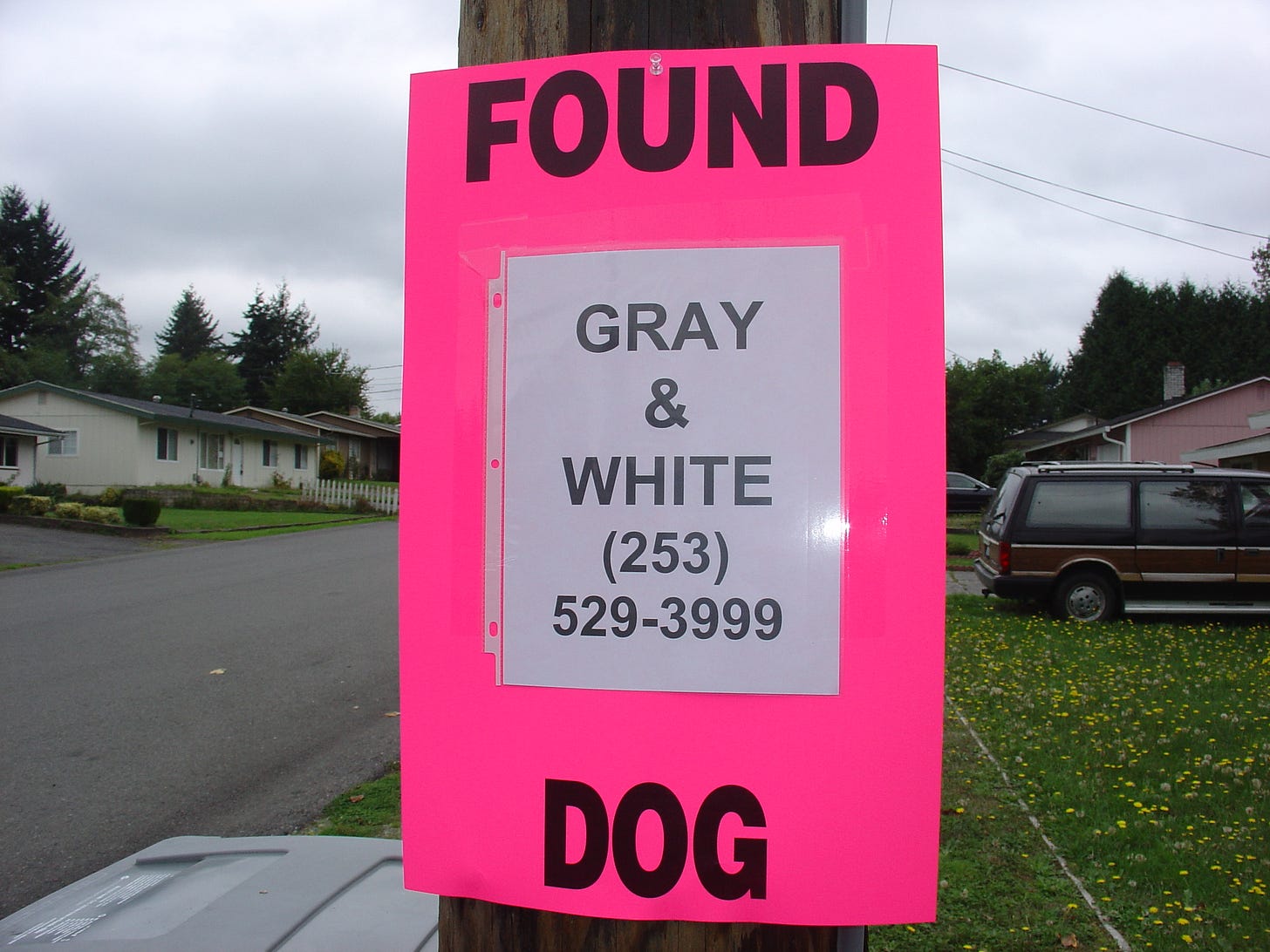STRAY: adjective \’stra \ “having escaped from a proper or intended place” (Merriam-Webster Dictionary)
The words that we use will often influence our perceptions and in turn, affect our behavior. For as long as I can remember, the animal industry has used the word “stray” to describe a loose companion animal, most often a dog or cat. Yet calling these found animals “strays” tends to mask the reality that a great majority of these caged, unclaimed shelter dogs and cats actually have a HOME that they escaped from. When you call a found dog or cat a “stray,” you strip away its identity as a potential beloved companion animal that already has home and does not need a new “forever home.”
I first shared the message “Think LOST, NOT Stray!” in a workshop at the 2009 Best Friends Animal Welfare Conference. I’m not sure why the message has taken so long to sink in with shelter workers, but thankfully there is a new push to recognize that MORE needs to be done to recover missing pets, including to change terminology used in animal welfare. For example, some shelters are starting to use the term “RTH” or “Return to Home” instead of the “RTO” or “Return to Owner” acronym which has been used for umpteen years.
In addition, some shelters are starting to change terminology when referring to the found cats and dogs that are brought into their shelters. One of our graduate students who works at the Tallahassee Animal Services (Tallahassee, Florida) was able to get the signage inside her shelter changed from “Stray Dogs” and “Stray Cats” to instead read “Found Dogs” and “Found Cats.” Instead of telling the public to “go look at the strays” they now instruct people to “go look at the found dog kennels.”

Some of the primary messages that the animal welfare and pet industry (and TV networks like Animal Planet) have used during the past twenty years have promoted the words “homeless,” “abandoned,” “dumped,” and “feral.” People who have heard messages that “millions of dogs are dumped every year” tend to leap to the conclusion that the dog that they find wandering along a road is homeless and was dumped, rather than considering that it could have a desperate owner trying to find their dog. The moment that your beloved dog or cat escapes from your care, it is called a “stray” and it is at risk of being treated as if it is UNOWNED and UNWANTED!
Why is this misinterpretation important? If you believe the dog that you find was dumped, YOU WILL NOT ATTEMPT TO FIND HIS OWNER! However, if you believe that the dog that you found is a LOST DOG, then you’ll likely transport it to a veterinarian’s office to have it scanned for a microchip. What we believe influences how we behave!
Do dogs get dumped and abandoned? Certainly, but not to the level that people believe! In order for most of the loose (found) dogs in our shelters to be unwanted “dumped” or “abandoned” dogs, we’d need to have hoards of people lining up every day just to dump so many dogs. Seriously, HOW LIKELY IS THAT?
Yet someone who BELIEVES that a dog was dumped is more likely to rehome that dog than make any effort to find the guardian who may have lost it.
In reality, we have many dogs escaping from their families on a daily basis—digging out from a yard, pushing through loose fence boards, climbing over fences, escaping after involved in serious car crash, escaping out an open door, bolting due to fireworks or thunder, chasing after a rabbit or deer while walking in the woods—in a mirid of ways because, well, they are dogs! They like to explore, follow scent trails, or chase game animals and they become panicked and run away in fear. Most of the dogs that are caged in our animal shelters were not dumped and they were not born in the wild. While there are some dogs that are truly born-in-the-wild and “feral,” the majority of the loose/found dogs brought into shelters were recently under the care of someone who was feeding that dog. So before you work to give a found dog or cat a new, forever home, THINK LOST, NOT STRAY!
We highly recommend that whenever you find a cat or dog, place a giant, neon FOUND DOG or FOUND CAT poster at the location where you found it. Chances are, the desperate family member who is driving around the area will see your sign and be reunited, without the dog needing to be transported to a local animal shelter.
Microchipping your pet, keeping a collar with a current ID tag on him, and using giant neon LOST DOG or LOST CAT posters if your pet is lost are absolutely critical to increasing the probability that you will get your pet back home. These things (microchips, collars with tags, and obnoxiously neon posters) will often convince rescuers that your dog is, in fact, LOST and not abandoned! And when it comes to finding a lost pet, you likely need all of the help that you can get!
Please consider making a small donation (by clicking the button below) to support my efforts to educate others in topics like “Think LOST, NOT Stray!”





One thing that has to change is the skipping of scanning for microchips ! I think there needs to be a law in place to make sure this happens whenever any animal is brought into anywhere with capabilities to do so! Further, there should be consequences for those who don’t do this! This simple practice would bring many lost animals home!
I bet adjusting nomenclature also gets people to think differently about the purpose of shelters in their area - from "housing unwanted pets" to "caring for pets waiting to be found by their families." Seems to shift from hopeless to hopeful.